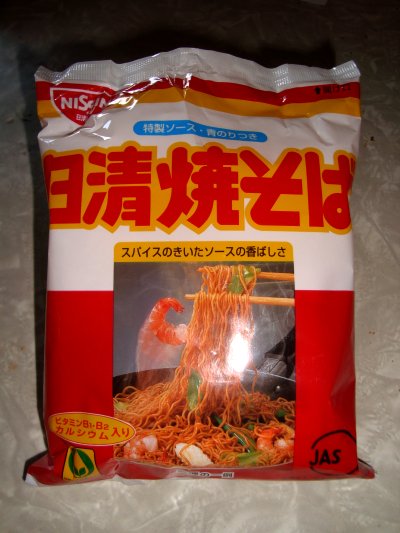
Whenever I go to my local Asian grocery store, the first place I go to is the back corner. It's a thirty-foot by thirty-foot square dedicated to nothing but different kinds of ramen and other instant noodles. The last time I was there, they were busy renovating the area, but one thing did catch my eye as I was rummaging through the vast quantities of noodles: a five pack bag of Nissin Instant Yakisoba noodles. I couldn't resist: I had to buy a bag and taste them immediately.
I quickly learned that Nissin's Yakisoba ramen isn't your typical instant-noodle treat. To start, it's not as overbearingly salty as most other ramen; it's actually a little sweet, with a well-rounded group of flavors instead of just one or two noticable ones. Second of all, and probably most importantly, instead of being boiled for a few minutes in a pot, it's boiled in a small pan and finished by stir-frying, giving an old classic a new twist.
Unlike most of the other ramen I buy there, this was entirely in Japanese, so I really had to stumble my way through making it. 220 mL (slightly less than a cup) of water goes into a small frying pan, and as soon as it comes to a boil, the noodles and sauce packet go in. The sauce powder, upon a preliminary sniff, smelled heavily of soy, but not much else.
As it cooked, I followed one of the diagrams on the back of the package and pulled the noodles apart with a fork, stirring it every now and then to make sure everything cooked evenly. As the soupy sauce started to thicken, it started to gain a nicer, sweeter smell as well, and when it had thickened enough that it was no longer waterlike in consistency, I pulled it off the heat and got ready to enjoy my yakisoba.
In addition to the sauce packet, the package came with an additional, smaller packet of finely crushed green seaweed that was supposed to be sprinkled on top, but I decided to hold off on that for the time being.
The noodles (sans seaweed) had a full, rounded out flavor that contained hosin sauce, soy sauce, five spice powder (the cinnamon and star anise were especially noticeable, but not overpoweringly so,) and ginger. Every flavor complimented one another without it being either too salty nor too sweet, and the touch of ginger added just a hint of spicy to the mix. All in all, they were very, very good.
...but then I added the seaweed. The little bit of seaweed in the pouch made the entire dish taste very grassy and vaguely like low tide; it singlehandedly knocked out the other flavors, much to my disappointment. But had it not been for that, it would have been very good. Next time I'll make sure to leave the seaweed out.
I quickly learned that Nissin's Yakisoba ramen isn't your typical instant-noodle treat. To start, it's not as overbearingly salty as most other ramen; it's actually a little sweet, with a well-rounded group of flavors instead of just one or two noticable ones. Second of all, and probably most importantly, instead of being boiled for a few minutes in a pot, it's boiled in a small pan and finished by stir-frying, giving an old classic a new twist.
Unlike most of the other ramen I buy there, this was entirely in Japanese, so I really had to stumble my way through making it. 220 mL (slightly less than a cup) of water goes into a small frying pan, and as soon as it comes to a boil, the noodles and sauce packet go in. The sauce powder, upon a preliminary sniff, smelled heavily of soy, but not much else.
As it cooked, I followed one of the diagrams on the back of the package and pulled the noodles apart with a fork, stirring it every now and then to make sure everything cooked evenly. As the soupy sauce started to thicken, it started to gain a nicer, sweeter smell as well, and when it had thickened enough that it was no longer waterlike in consistency, I pulled it off the heat and got ready to enjoy my yakisoba.
In addition to the sauce packet, the package came with an additional, smaller packet of finely crushed green seaweed that was supposed to be sprinkled on top, but I decided to hold off on that for the time being.
The noodles (sans seaweed) had a full, rounded out flavor that contained hosin sauce, soy sauce, five spice powder (the cinnamon and star anise were especially noticeable, but not overpoweringly so,) and ginger. Every flavor complimented one another without it being either too salty nor too sweet, and the touch of ginger added just a hint of spicy to the mix. All in all, they were very, very good.
...but then I added the seaweed. The little bit of seaweed in the pouch made the entire dish taste very grassy and vaguely like low tide; it singlehandedly knocked out the other flavors, much to my disappointment. But had it not been for that, it would have been very good. Next time I'll make sure to leave the seaweed out.

In Japan, cooking CHICKEN RAMEN the way we do yakisoba is very popular.
ReplyDeleteCook with fewer water, (add some shredded celery if wanted), drop sesame oil and stir a while after losing water.
It's really good. some people add shredded chicken, crashed peanut, etc.
Here is someone else's page introducing this.
http://blog.goo.ne.jp/aneyan555/e/5d164d0299eab53caad1629a56c0aedd